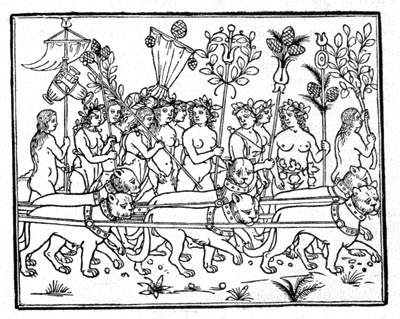|
|
previous | 10 January 2006 | next
Once again, I'm buried in commercial work. But over the last few days, friends have been recommending all kinds of cool stuff to me that I will follow up on once things open up:
Via Casey Smith, the Hypnerotomachia Poliphili - I bet Aubrey Beardsley studied the illustrations in great detail.

The enigmatic, polyglot Hypnerotomachia Poliphili -- the inspiration for the bestselling novel The Rule of Four -- has fascinated architects and historians since its publication in 1499. Part fictional narrative and part scholarly treatise, richly illustrated with wood engravings, the book is an extreme case of erotic furor, aimed at everything -- especially architecture -- that the protagonist, Poliphilo, encounters in his quest for his beloved, Polia. Among the instances of the book's manifesto-like character is Polia's tirade defending the right of women to express their own sexuality, probably the first sustained argument of this type, which lifts the book's erotic theme from the realm of ribaldry to the more daring one of sexual politics.
Via Brandon Morse, the research of Paul Debevec, particularly in regards to 3D modelling from 2D sources. Of particular interest:
Façade itself remains an unreleased research prototype, but a good deal of its functionality is now available in commercial products. Façade was a source of inspiration for MetaCreation's product Canoma written by Robert Seidl and Tilman Reinhardt. In August 2000 Adobe Systems acquired Canoma and will be integrating its technology into a new project to be released at a future date. Along with computer vision research led by Olivier Faugeras at INRIA, Façade is also a source of inspiration for RealViz's ImageModeler 2.0 image-based modeling and rendering package. Other related software was recently surveyed in an article (click here) by Terrence Masson in VFXPro.com, November 20, 2000.
And via Alberto Gaitán, the art of Patrick Killoran:
During June 2003 New York artist Patrick Killoran deliberately set out to lose 500 identical wallets in Birmingham's city centre. Each had precisely the same contents, including business cards, receipts, health certificate, ID card, hand written notes and a condom, to create a portrait of a Mr Thomas Swallow, a fictional character from a non-existent country, Tierra del Mar.
As Killoran explained, 'The wallets belong to a person from a utopian place. They are full of references to the possibilities of perfect worlds, from Thomas More to Walt Disney.' Their meaning was open-ended, potentially the source of urban mythology through the artistís covert activity.
The wallets were abandoned in a variety of public places including shops, telephone boxes and bus stops. Their fate was completely undetermined. Some wallets were kept, others were handed in to lost property offices, many may still remain undiscovered. Some were brought to the attention of the Birmingham Police, resulting in the project being stopped.
|
